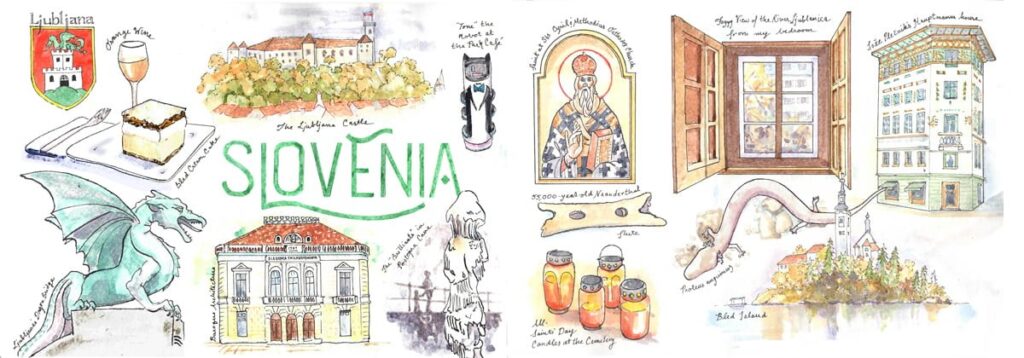
What luck we had visiting this country that, a couple of months ago, I couldn’t even find on the map! I always say to my non-EU friends and family that should they make the trip to Europe, I’d go wherever to meet up with them. Thus my dear friends John & Claire let me know that they would be in Slovenia this fall and I flew to join them.
As usual, geography first: One of our tour guides, Anna Marie, of Roundabout tours, compared the map of Slovenia to the image of a “squashed chicken”, with the head and open beak stretching east into Hungary, the plumed legs poking down into Croatia, and the pope’s nose (butt) reaching towards the Austrian Alps. The aerial view shows Slovenia’s capital, Ljubljana, centrally nestled in the valley around the curves of the river Ljubljanica. The Julian Alps are visible to the northwest, and forests cover about 65% of the country. Slovenia, along with Croatia, Serbia, Bosnia & Herzegovina, Macedonia and Montenegro once made up the former Yugoslavia. Among those countries, Slovenia is the most successful, with only 5.5% unemployment, and an excellent education system. We had no difficulty communicating as it seemed everyone we met spoke excellent American. In 2016, it was declared the first Green country in the World. Their tourism industry prioritizes ecology.
Coming from dry southern France, I reveled in all the water everywhere: The limestone/dolomite character (called Karst) of western Slovenia is permeated with rivers above and below ground. We took advantage of excellent guided tours to get out of the city. One of these, with TodoinSlovenia, and our charming, informative guide José, took us to visit the phenomenal Postojna cave, carved by the river Pivka, and Predjama Castle, a medieval fortification integrated into another series of caves.
I’m not fond of the idea of descending 100 meters underground, but the cavern ceilings were so vast, there was no feeling of claustrophobia in Postojna. A tiny open train takes one 3.2 km into the cave, where the visitor walks another 1,5 km along a path to see some of the jaw-dropping stone formations. There’s even a chamber so big there are concert performances there that can host 10,000 people! At the end of the tour, before emerging into the light, there’s a darkened aquarium, which houses a few indigenous troglodytic salamanders, the blind “Little Dragons”, Proteus anguinus, which are only found deep in the caves of the region.
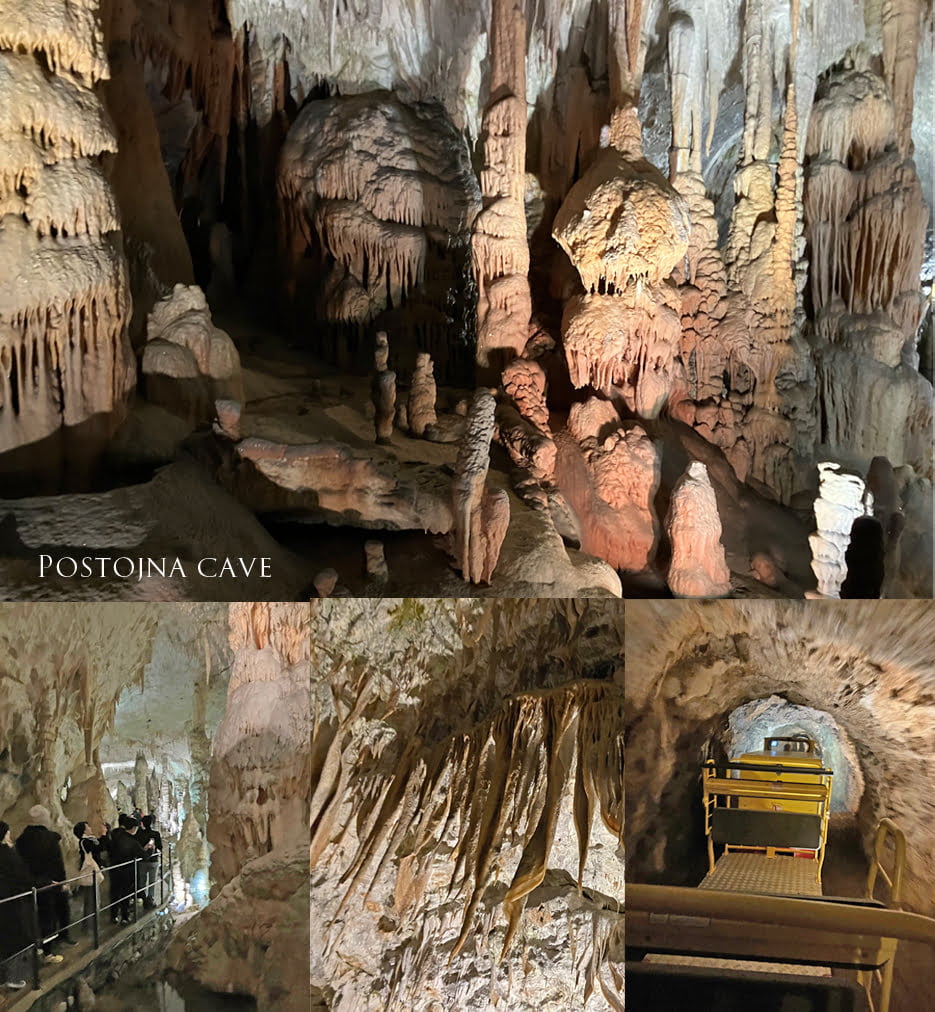
In the history of Predjama Castle is a Robin Hood-type character named Erazmus of Lueg. In the 15th century, he was based in the impregnable castle, which tucks into a 123-meter cliff, to fend off his Hapsburgian enemies for almost a year, using the hidden caves behind the 13th-century structure to elude the siege.
On another excursion, this time with Roundabout tours, we drove NW from Ljubljana towards the Julian Alps. We made a brief stop to visit the medieval town of Skovja Loka (I don’t have access to accents here to put the little new moon over the “S” which transforms it to “sh”). I would like to return to Slovenia to visit more of these perfectly preserved (and still inhabited) villages. Slovenians seem to enjoy a decorative approach to their façades, with pretty patterns and colours. Each house on the main street of Skovja Loka is distinctive. This served as a handy reference before they assigned numbers to the addresses. “Just turn right and I’m in the beige house with the bears…”
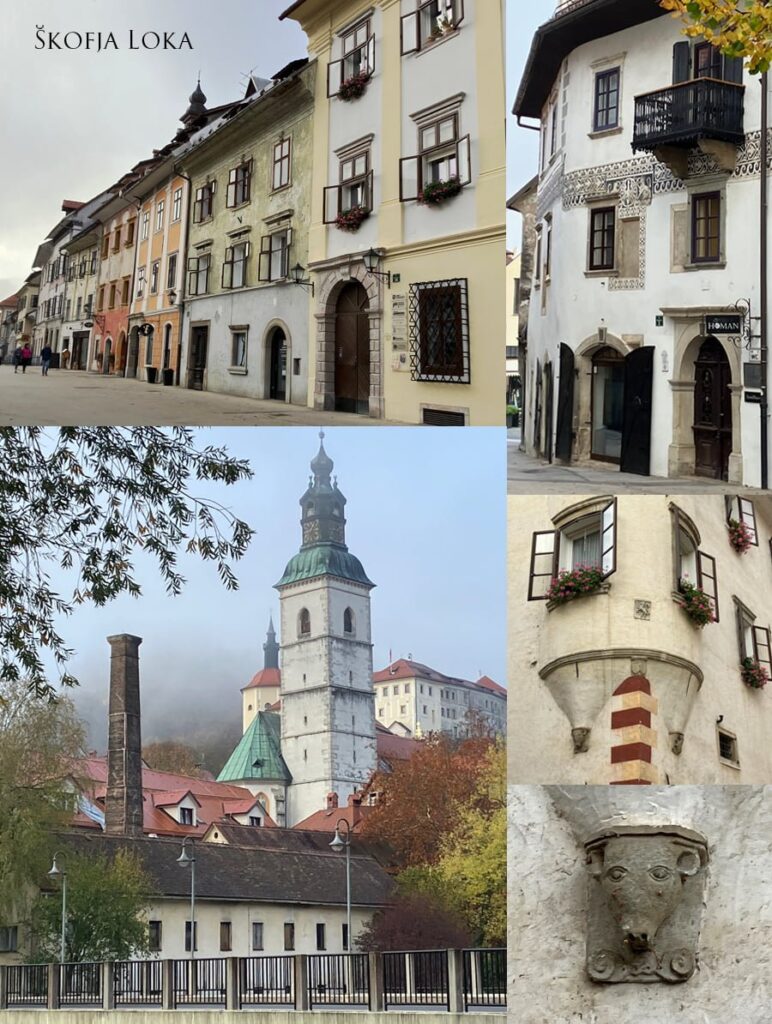
After the village, we made our way to Vintgar Gorge, where the Radovna river carves a sharp and picturesque ravine, along which enterprising 19th-century tourism entrepreneurs built a handy wooden walkway which takes one 1.6 kms to end up at the tallest Slovenian waterfall, the Sum. Because we were there in late October, the sun didn’t reach the depths where we walked, only burnishing the gorge crests with gold.
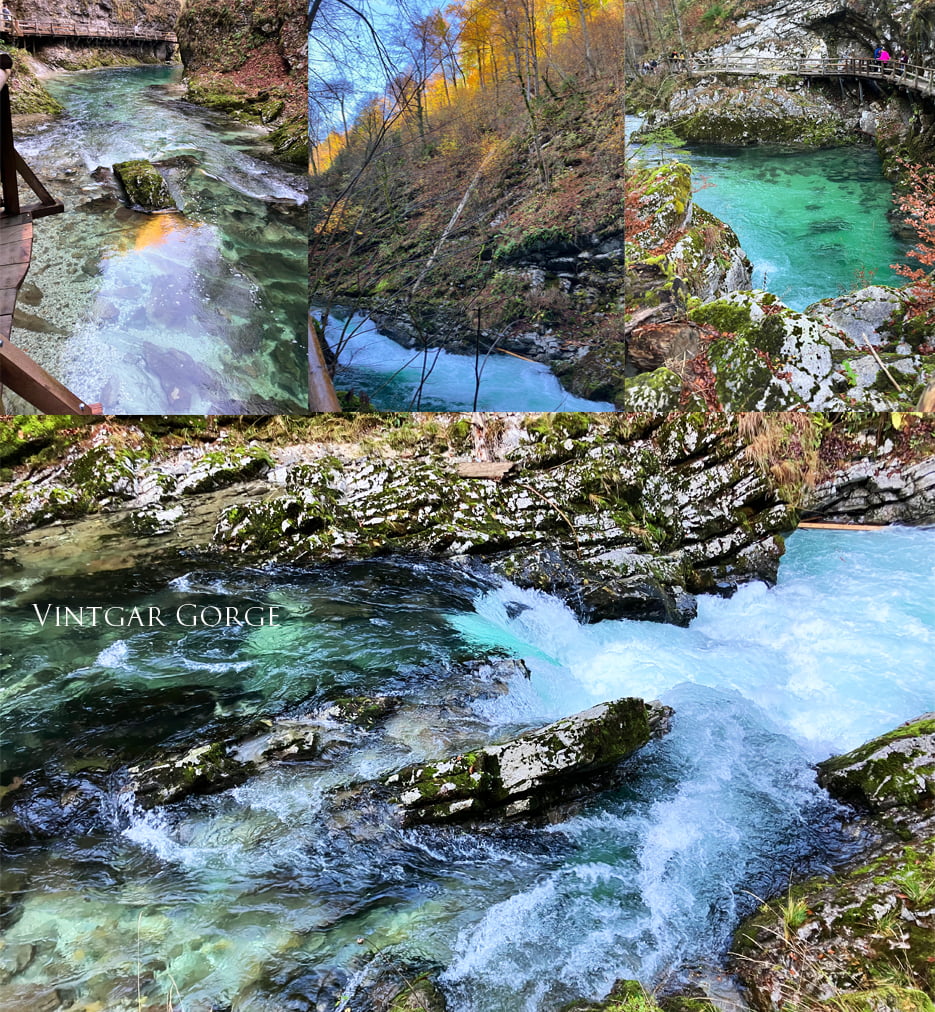
Also within the Triglavski narodni Park is the magnificent Bled Lake. Online, its fairy-tale look led me to believe that it would be typically overrun with touristy degradation. Not so! Residents and visitors are expected to maintain Bled’s pristine nature, and it won 2nd place in Europe for sustainable development. It is the most peaceful human-occupied place I have ever visited. No motor boats are permitted on the lake, so it is entirely quiet, something enhanced by this region’s particular lack of wind (something I appreciate, coming from wind-blown Provence). Back when Slovenia was under Hapsburg control, the imperial government granted a handful of families the right to operate man-powered gondolas. Even today, those families pass on this right to their sons (not daughters…hmmm).
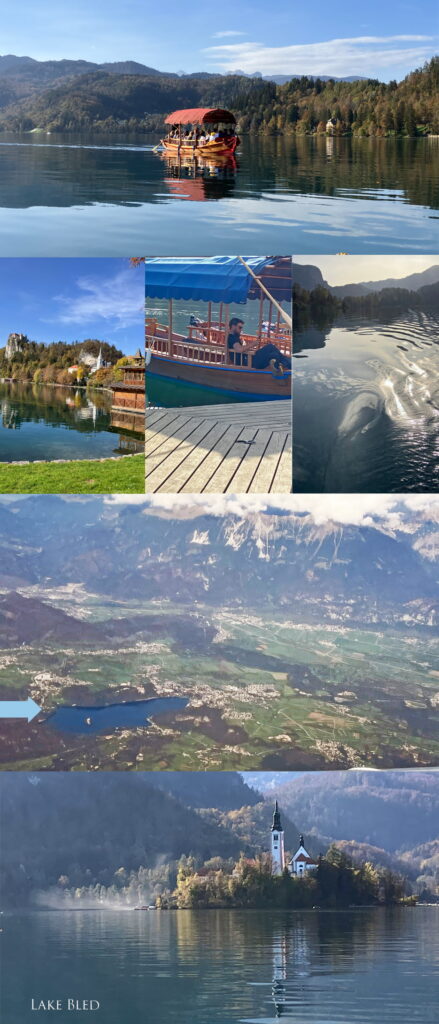
It was late, and the sun was behind the mountains, when we finally reached our day’s final stop: Bohinj Lake. It is another pristine lake, which perhaps would have made a more optimal during swimming season.
Our home base was a lovely and spacious apartment in the old town, with views of Ljubljana Castle and the river. Our first day we took a walking tour from the extremely helpful Visitors’ Centre nearby. (It was through them that our tours were arranged) Andre, our humourous guide, took us through the town, starting at City Hall, where we saw a handsome engraved map of 17th-century Ljubljana, with the adjacent Roman town of Emona, in the province of Istria, carved to the East.
In the entrance to the Building is the bust of Ljubljana’s well-loved mayor, Ivan Hrbar, who benevolently presided over rebuilding the city after the 1895 earthquake, including the unusual Triple Bridge. When the Italian occupation armies offered him the mayorship under Fascist rule, he chose to leap to his death in the river, wrapped in a Yugoslav flag. (They don’t make politicians like that anymore…)
After the tour, we wandered around the city, with new appreciation for the unique gifts of the architect Joze Plecnik, 1872-1957 (accents on the z—pronounced zje, and c, pronounced “ch). He used influences from the Secessionists, as well as wacky Egyptian, folkloric and anything that struck his fancy ideas. He certainly was in a class of his own.
The riparian nature of the capital means that dense fog quilts the town every morning, burning off by 10:00. The Slovenian flag represents this, with white above the blue of the omnipresent water. An image of the castle adorns the centre of the flag of Ljubljana. Atop the tower crouches the Ljubljana mascot since the Baroque era, a dragon. Mythology has it that Jason (of Golden Fleece fame) hung around the area while resting from his adventures. South of the city are marshes, which were inhabited by a fierce dragon, which Jason slayed. (Claire and I explored those parts on our last day, grateful for the dragon-less hike.) That dragon, which perhaps represents the suppressed pagan past of the now Christian city, adorns the Dragon bridge, built under the benevolent Ivan Hrbar administration, in 1895.

Our first introduction to the complicated Slovenian past was the array of emblems in City Hall representing 3 historical periods (not including the Fascist occupation, nor the Yugoslav Communist epoch) that constituted their story.

Of course, the actual trajectory towards independence was a lot less straight. At first there were Celtic settlements, conquered by the Romans. Their town of Emona, in the province of Istria, was overrun by Attila the Hun. In the middle ages, slavic tribes settled in, establishing the duchy of Kocelj. The region was then incorporated into the Holy Roman Empire. I think the one-headed eagle was the emblem of this period, with Emperor Otto presiding. The district of Carniola, within the borders of the present country, belonged to a series of bishops and princes until, in the late 13th century, the Hapsburgs acquired the province. All the while, the region was intermittently invaded by the Ottomans. The Austro-Hungarian province of Carnolia was the seat of Slovenian nationalism, which got a boost, along with some democratic innovations, when the conquering Emperor Napoleon decreed that Slovenian be recognized as the national language of the Napoleonic province of Illyria.
The end of World War I saw the creation of a united Yugoslavian Kingdom (although 70% of Slovenians voted against merging with their Croat & Serbian brethren). At the beginning of the second World War, fascist Hungary, Italy and Germany joined together to invade and occupy Yugoslavia. By the end of the war, the Slovene Partisan army, together with the Soviets and Yugoslav army, freed the area, at the expense of many Slovenians’ personal freedom. A major figure in the resistance was Josip Broz Tito who, while presiding over a communist regime, refused to harness Yugoslavia to the Stalinist Soviet Union. I’m sure there are plenty of CIA stories relating to this period. Tito died in 1980, which marked the beginning of the dissolution of Yugoslavia.
In late 1990 a referendum on Slovenian independence from Serbia-dominated Yugoslavia passed and 6 months later Slovenia was declared a separate country. Unlike the other pieces of the old Yugoslavia, which engaged in a lengthy and bloody war for independence, Slovenia only suffered 10 days of military conflict before peace. In 2007 Slovenia joined the European Union, and thus I was able, on my French identity card, to bypass the longer security lines.
Super complicated, yes! But all that rich, if violent, history makes for some interesting culture. I hadn’t time to visit as many museums as I would have liked, but did check out the national Museum of Slovenia, where we could see some Slovenian folk art and cultural items. Slovenia has many festivals, and the paganistic Kursentovanje festival marking the end of winter looks very curious, with its shaggy monsters roaming the streets. We also were able to see bronze-age items and even a Neaderthal flute—the oldest instrument in the world from 50-60,000 years ago.
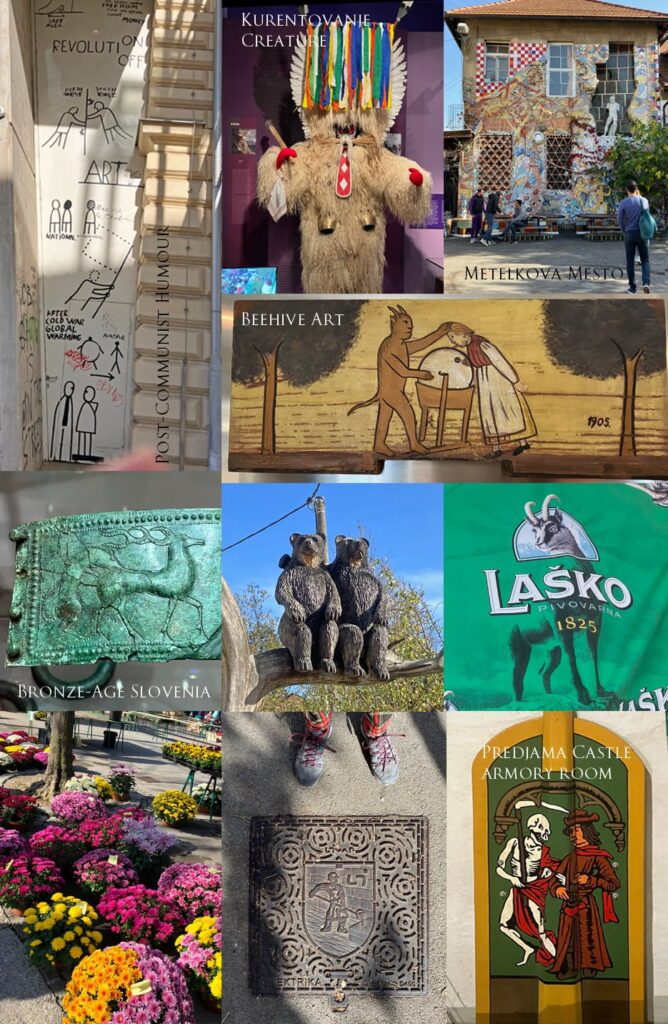
Some of the sites we did get a chance to visit were Metelkova Mesto, a disappointing assemblage of artist squats, and the much more satisfying Tivoli Park, where Holiday makers (we were there for the 4-day weekend which celebrated both Sovereignty Day and the Day of the Dead) strolled around in the unseasonably warm and sunny weather. We also inspected the flea market (where John spotted a nostalgia book about Tito), and were lucky enough to partake in the Open Kitchens, held every Friday until October 28th—the last one! In this venue, restaurants from town offer their very varied fare, and we enjoyed 3 varied lunches among us. I don’t eat meat, and I don’t like beer, so I couldn’t enjoy the variety as much as my buddies could.
And speaking of food and drink, everything we ate, whether at restaurants or chez nous, was of excellent, fresh quality. I must mention 2 restaurants which impressed me with their food and Slovenian wine, : TaBar and Zlata Ladjica. I was introduced to Slovenian Natural wines, which are unfiltered, organic, and with no added yeast, so lower in alcohol. I liked their version of Proseco, which usually gives me a headache, but this one didn’t. I also tasted my first “Orange Wine” which is made by macerating white grapes with their skins and seeds and aged in ceramic (not oak) to create an Indian yellow-coloured wine.
Between rural outings, we visited various City attractions, among them the church of Saints Cyril & Methodius which smelled charmingly of beeswax. Although Slovenia is 72% Roman Catholic, I wanted to take the opportunity to visit an orthodox church while in Eastern Europe.

On Halloween, I took a cab over to the Plecnik-designed cemetery, where every single grave was adorned with candle lanterns. At the entrance, florists sold wreaths and candles, which hundreds of families were buying up to honour their dead. Far from a macabre affair, it was pretty lively with children happily trotting among the graves. Like every other experience I had in Slovenia, I was struck by the civic-mindedness and calm I witnessed there. A great introduction to a different Europe.

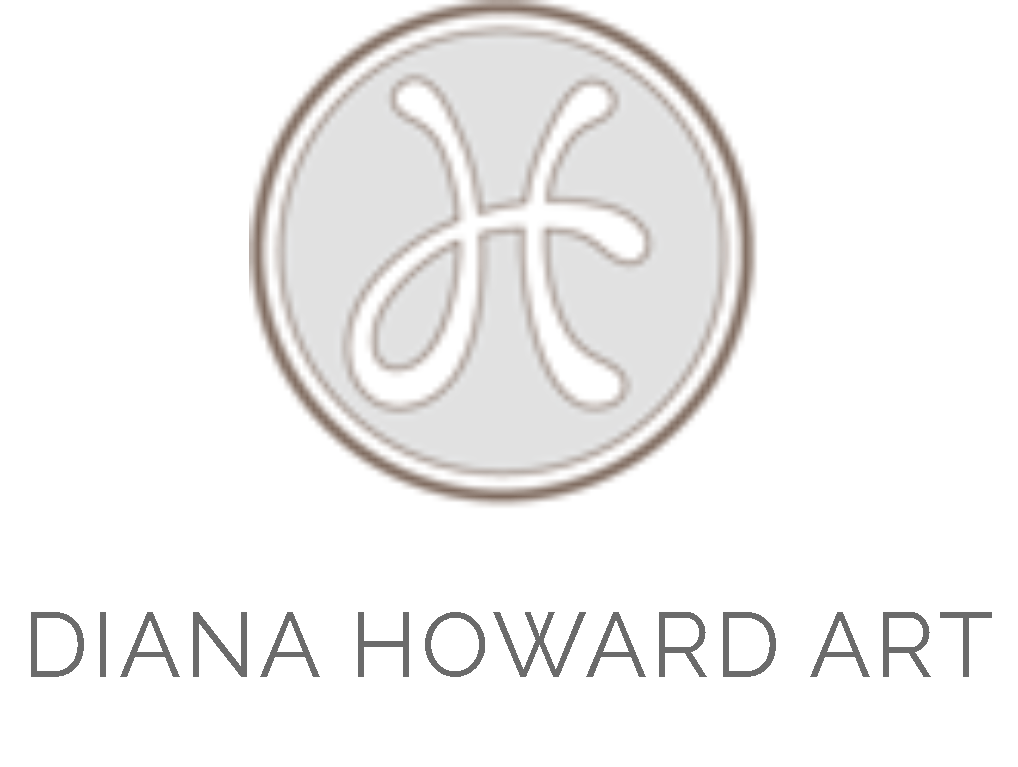
What a wonderful trip, and your description of it. A little remark, it’s not Halloween, it’s All-Saints celebration (la Toussaint), a strong catholic tradition we also have in Poland
Hello Magda! Thank you for looking at my post. Where do you live? Poland is another country I’d like to visit. As for my calling the visit I made Halloween i used that term instead of All Saints’ Day is because I went on the night of Oct 31 and wasn’t sure whether the night before still constituted le Tous Saints. All the best!
I also liked reading this very much, Diana. All Saint’s Eve is fine in English, as far as I know. And the original Halloween means “(All) Hallow(s) e(v)en(ing)”. It’s true that Halloween has been coopted by capitalism but its roots lie in this word, hallow, to respect or honor greatly; revere, or to make holy or consecrate.
Wikipedia confirms:
“In the Western Christian practice, the liturgical celebration begins with its first Vespers on the evening of 31 October, All Hallows’ Eve (All Saints’ Eve), and ends at the compline of 1 November. It is thus the day before All Souls’ Day, which commemorates the faithful departed. In many traditions, All Saints’ Day is part of the season of Allhallowtide, which includes the three days from 31 October to 2 November inclusive, and in some denominations, such as Anglicanism, extends to Remembrance Sunday.[14][15][3] In places where All Saints’ Day is observed as a public holiday but All Souls’ Day is not, cemetery and grave rituals such as offerings of flowers, candles and prayers or blessings for the graves of loved ones often take place on All Saints Day.
Nice to hear from you Heather! Happy Thanksgiving. I hope you and your family are well.
Wow. What a wonderful trip. Thanks for sharing Diana. You are quite the travel writer!
Love to you
Thank you, dear friend, for documenting our marvelous trip together! I’ve passed along this link to many of my local friends when they ask what Slovenia is like — your words and images say it best. XXOO
Hey, sharing the experience with you two was the best part of the trip!
Great introduction and guide for our trip this summer Diana! Thanks for your drawing, photos and interesting facts that will help us choose our itinerary. I particularly am grateful for the direct links and your personal tips! Gratitude indeed